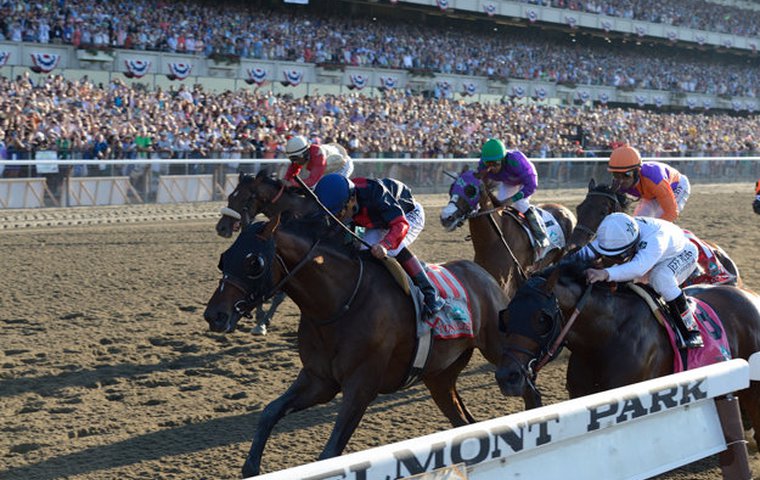
Racing analyst James Willoughby looks back at the victories of Tonalist and Australia in the two great Classics on either side of the Atlantic this past weekend.
The Belmont Stakes confirmed that California Chrome is a horse best served when the accent is more on speed. The three horses who finished in front of him – Tonalist, Commissioner, and Medal Count – all have pedigrees with more proven stamina influences close up. As Janet Hickman argued at the tail of this article here last week, Tonalist and Commissioner had the standout Belmont pedigrees. And Medal Count’s sire Dynaformer has winners of the Melbourne Cup and English St Leger on his résumé.
As Occam’s razor dictates, the least-convoluted explanation is usually the best. The 12 furlongs of the Belmont were the most California Chrome has tackled; he travelled smoothly until the straight, and then could not get past horses who kept going better. It is most probable that he failed because the distance was too far.
Some highly respected analysts – such NBC’s Randy Moss and Andy Beyer – have suggested that California Chrome should have been kicked into the lead earlier in the race by Victor Espinoza. But, to assert that tactics were to blame requires proving the hypothesis that California Chrome could have covered the distance faster – enough to reverse his one-and-three-quarter-length defeat.
There is just no support for the concept that California Chrome would have benefitted from greater aggression from his fractional times. Assuming a horse length is 8.5 feet, and thus a length is worth 0.16 seconds in a race that was 2:28:52, here are the fractional times for California Chrome at each point of call using the lengths back quoted in the official chart and some interpolation:
24.22 – 24.61 – 24.35 – 24.33 – 25.34 – 26.05
Look at the pattern described by his fractions: Like many horses in dirt races, California Chrome was decelerating from an early stage. I don’t see how it is fair to assert that California Chrome could have achieved a faster overall time by being forced to run harder early on. Had he run any faster early, he would have tired even more. That’s the seesaw relationship between early pace and finishing speed evident in all fractional times.
California Chrome’s Belmont performance was not bounded by his lack of pace – he didn’t need to be made more use of early to compensate for any lack of acceleration. His performance was bounded by his lack of stamina – he could not sustain even the pace that he was asked to run at, never mind a faster tempo. The three who finished in front of him also got tired, but they kept going better.
However, it also isn’t safe to project how California Chrome might have performed in a different scenario without also considering how the other jockeys would have reacted. Surely, given the doubts about Chrome handling the distance, his rivals would have pressed him; and a stronger pace would have suited them better anyway. It’s just not safe to rely on projections like these without considering the new, hypothesised scenario from a game-theoretical perspective.
Being ridden in behind horses seemed to do no harm to California Chrome either. He travelled well for 10 furlongs and did not back off from the kickback or contact as he had done when much further back and in far-worse traffic in the Del Mar Futurity last year. Surely you can’t compare that debacle with his untroubled run in the Belmont. Chrome also had to angle out from behind horses when winning the Kentucky Derby and it didn’t throw him off form there.
The winning time of the Belmont was not bad, but further strengthened the trend I described before the Derby. Tonalist received a Beyer Speed Figure of 100, which is the equal best of the last seven years. Horses win allowance races over shorter distances with figures better than this, and the mass of data seems to give so much weight to what Hickman argued: American pedigrees have become unbalanced and Classic horses just don’t stay as well as they used to.
In the Epsom Derby, the type of epic drama that the Belmont served up wasn’t in evidence. The winner, Australia, gained Aidan O’Brien and Coolmore a record third straight victory, and the Ballydoyle trainer makes brilliance look routine.
For his part, Australia was barely troubled until the last 75 yards, when he seemed to be tiring a little. But this may be deceptive: Throughout the race he covered extra ground and made a sweeping move while the pace was still hot. He won by an official margin of a length and a quarter, but trebling that may be a better guide to his superiority.
While the Derby is just the start of a great summer of flat racing in Europe, there is always a feeling of anti-climax stateside after the Triple Crown races have been run. We will see what develops in races like the Haskell Invitational Stakes and the Travers Stakes while California Chrome recovers from the nasty nick he picked up in the Belmont


